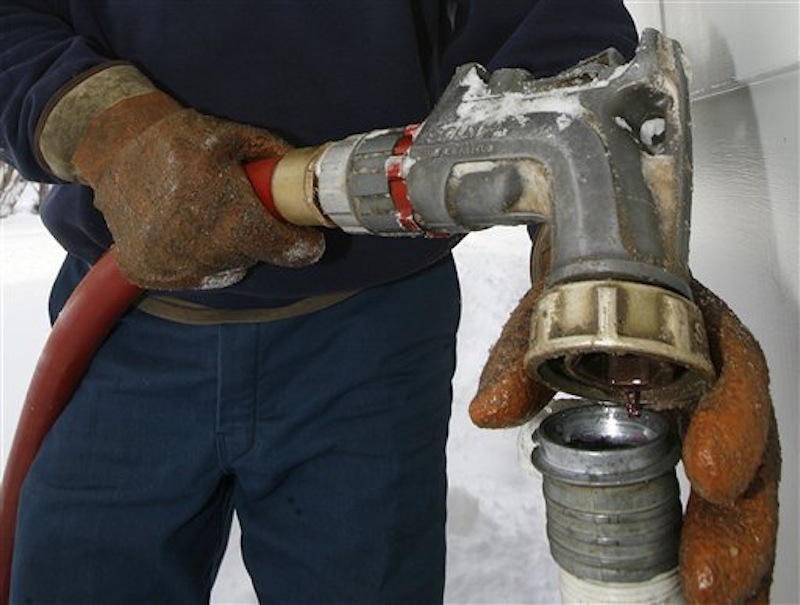WASHINGTON — Mary Power is 92 and worried about surviving another frigid New England winter because deep cuts in federal home heating assistance benefits mean she probably can’t afford enough heating oil to stay warm.
She lives in a drafty trailer in Boston’s West Roxbury neighborhood and gets by on $11,148 a year in pension and Social Security benefits. Her heating aid help this year will drop from $1,035 to $685. With rising heating oil prices, it probably will cost her more than $3,000 for enough oil to keep warm unless she turns her thermostat down to 60 degrees, as she plans.
“I will just have to crawl into bed with the covers over me and stay there,” said Power, a widow who worked as a cashier and waitress until she was 80. “I will do what I have to do.”
Thousands of poor people across the Northeast are bracing for a difficult winter with substantially less home heating aid coming from the federal government.
“They’re playing Russian roulette with people’s lives,” said John Drew, who heads Action for Boston Community Development, Inc., which provides aid to low-income residents in Massachusetts.
The issue could flare just as New Hampshire votes in the Republican presidential primary.
Sen. Olympia Snowe, R-Maine, said she hopes the candidates will take up the region’s heating aid crunch because it underscores how badly the country needs a comprehensive energy policy.
Several Northeast states already have reduced heating aid benefits to families as Congress considers cutting more than $1 billion from last year’s $4.7 billion Low Income Home Energy Assistance Program that served nearly 9 million households.
Families in New England, where the winters are long and cold and people rely heavily on costly oil heat, are expected to be especially hard hit. Many poor and elderly people on fixed incomes struggle with rising heating bills that can run into thousands of dollars. That can force them to cut back on other necessities like food or medicine.
“The winter of 2011-12 could be memorable for the misery and suffering of thousands of frigid households,” New Hampshire’s Concord Monitor newspaper said in an editorial. “Heating oil prices are expected to hit record highs, and federal fuel assistance may reach a record low for recent years.”
Higher home heating oil prices and more families seeking aid due to the sour economy are straining resources. There’s a 10 percent surge in new applicants in Boston, Drew said.
“Our whole program could hit a rock soon,” said Mark Wolfe of the National Energy Assistance Directors’ Association.
Families can expect to pay, on average, about $3,300 to heat a home with oil this winter in New England, Wolfe said. That’s about $500 more than last winter. About half of the region’s homes use oil heat.
Congress, which is locked in a bitter battle over reducing spending, still must decide how much money to give the program for the budget year that began Oct. 1.
In fall 2008, amid concerns about rising fuel prices, the government nearly doubled fuel assistance, releasing $5.1 billion to states for the following winter.
But last February, President Barack Obama proposed cutting the program nearly in half, calling for about $2.5 billion. The House is considering $3.4 billion for fuel assistance, while the Senate reviews a $3.6 billion proposal.
Snowe, along with Sen. Jack Reed, D-R.I., and Bernie Sanders, I-Vt., are pushing for $4.7 billion, last year’s funding level, but they face long odds.
The government has given an initial round of funding, $1.7 billion, to the states.
In Maine, one of the coldest states, the average benefit has been reduced by about $500. The state’s average benefit last winter was about $800 among 63,842 households served. The average income of recipients was $16,757. About 80 percent of Maine households use oil heat.
“It’s a very serious situation,” Dale McCormick, director of MaineHousing, a state agency that administers heating aid, said. “We can’t send out money we don’t have.”
That view is shared by home heat aid advocates across New England and into New York and Pennsylvania. Most of those states have cut benefits. New Hampshire has tightened eligibility requirements.
Vermont’s average benefit was cut from $866 to $474. New York’s maximum benefit this year is $500, down from $700 last winter. Pennsylvania’s minimum benefit is dropping from $300 last year to $100, Wolfe said.
“We have a lot of terrified people who can’t see how they are going to survive,” said Drew.
Send questions/comments to the editors.


